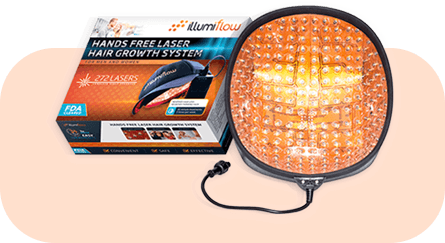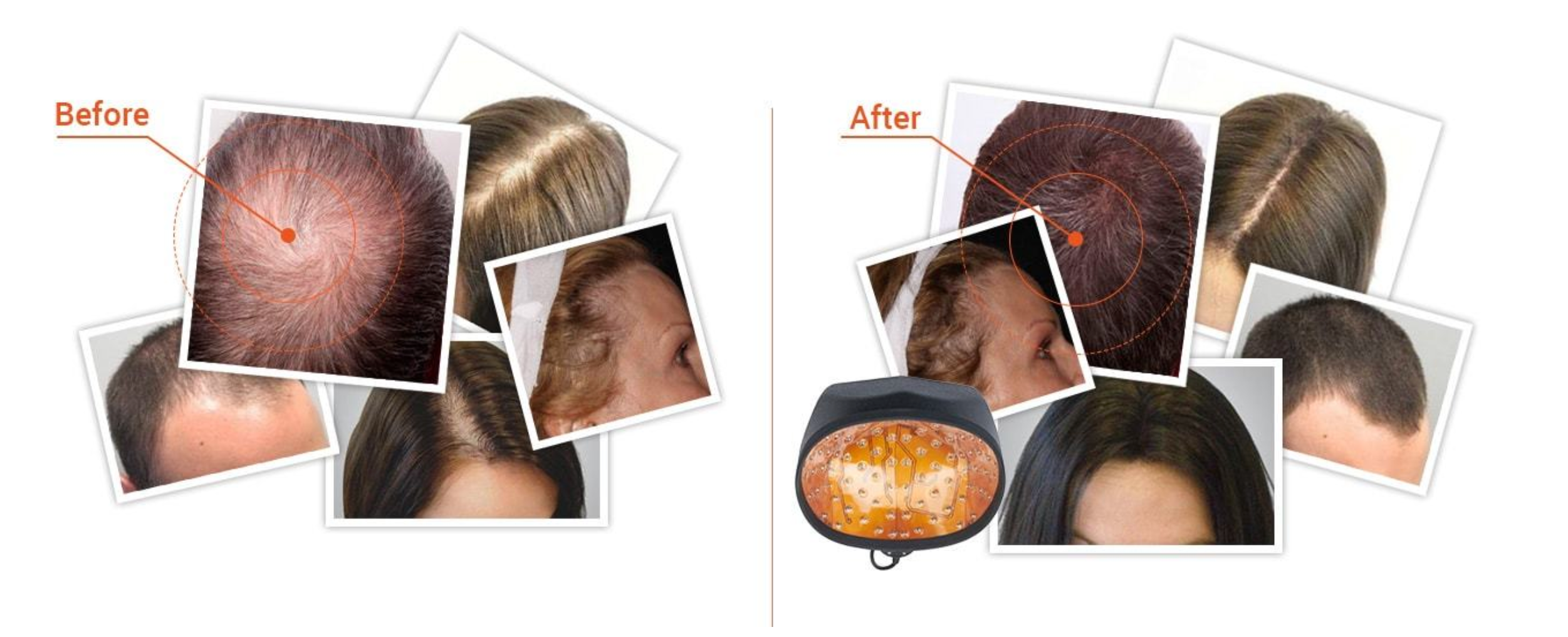Low Level Laser Therapy vs. Hair Transplant: Cost & Expectations

It’s most likely safe to say that suffering from hair loss or a receding hairline is hard enough minus the difficulty of how to grow it back.
There’s laser therapy, hair implants, hair transplants, prescription drugs, etc.
Which one are you supposed to turn to?
But does the decision between hair loss treatments have to be complicated?
What if you were given a clear cut way of weighing the pros and cons of two popular treatments that work, thus eliminating the trouble of having to make a decision?
Let’s observe the difference between low level laser therapy versus getting a hair transplant, and what the cost and expectations of each look like.
Before we get started, you may find it beneficial to take this quiz for assessing your hair loss situation.
Ready? Let’s get started.
Types of Low Level Laser Therapies and Hair Transplants
Low Level Laser Therapy
Now often referred to simply as LLLT, low level laser therapy was initially discovered back in the late 1960’s by a Hungarian scientist named Endre Mester. While Mester was experimenting with lasers for other medical purposes, he discovered that low-level laser light can regrow hair.
Cold lasers are the specific sort of laser used in LLLT for hair to produce a very specific form of red light. Decades of research have proven coherent red light between the wavelengths of 630nm and 670nm to be the optimal frequency for stimulating new hair growth.
The number of diodes available in a laser cap determine the overall effectiveness of the device. For instance, a laser cap with 148 diodes will be more effective than a laser cap with only 80. A laser cap with 272 diodes (like the illumiflow laser cap) will obviously be significantly more impactful than a laser cap with 148 diodes.
So we know that a specific form of light directed from a special sort of laser can help to promote new hair growth but how does that interaction actually work?
By treating the base of your hair follicles, red light energy is able to stimulate and re-energize the mitochondria of your cells. Since mitochondria are considered to be the “powerhouse” of the cells, reviving them is effectively the same as breathing new life into a retired power plant.
Once recovered to the point of healthy function, the mitochondria are able to reproduce and repair follicles on the scalp just like they were meant to. This results in noticeably thicker, healthier hair and eventually even new hair growth from previously dormant follicles.
Hair Transplants
A hair transplant is a type of surgery that moves hair from one area of the body to another. This minimally invasive procedure has been carried out in the United States since the 1950s and is commonly used for male pattern baldness.
The two most popular types of hair transplants are FUSS and FUE.
Follicular Unit Strip Surgery (FUSS) involves removing a strip of skin from a non-balding area. This donor site is usually the back of the head. The cut is then closed and hidden by the surrounding hair.
The strip of scalp that is removed is divided into tiny sections called grafts, each containing just one hair or a few hairs. These are each relocated to the balding areas being treated known as the recipient sites.
One of the main disadvantages of FUSS transplants is that they typically lead to scarring around the donor site. Some people may also experience pain and swelling in this area.
Follicular Unit Extraction (FUE) surgery involves shaving the back of the head and then removing individual hair follicles, as opposed to taking an entire strip of scalp.
The donor sites heal relatively well. Only small dots are noticeable but these are covered by the surrounding hair.
As with FUSS, the surgeon will prepare the grafts and place them onto the recipient areas. The entire process takes between four to eight hours, depending on the transplant size.
Usually, FUE is less invasive than FUSS, and there is a lower likelihood of experiencing complications, such as scarring or post-operative pain. Also, the hair follicles can be removed from several areas, rather than from one single site, so hair thickness at the donor sites is not affected.
So what can you expect from these two methods?
Expectations of LLLT and Hair Transplants
What to Expect from LLLT?
While the process of hair regrowth looks different for everyone, experience has provided at least a beginning framework of what is reasonable to expect in most cases.
Most users of the illumiflow laser cap see results in four to six months. Hair growth will progress in relatively predictable phases.
The first phase of renewed hair health can be noticed in existing hairs. As the roots of your hair begin to deepen, the follicle is able to access more nutrients, allowing it to begin the process of healing itself. This first phase results in healthier and thicker existing hair.
As the health of the hair and scalp returns, you’ll begin to notice new growth of baby hairs even as the existing hair continues to thicken and regain its healthy sheen. These new hairs are one of the most exciting results of effective hair restoration.
Before long, these baby hairs will develop into naturally strong and healthy hair follicles, just like their pre-existing neighbors. The amazing thing about this whole process is that it is completely painless and non-invasive.
Unlike many other solutions to hair loss, low level laser therapy promotes natural, sustainable change over time, meaning that, while it might take a little longer than surgery, your new hair is there to stay.
What to Expect From Hair Transplant Surgery?
Expectations for hair transplant surgery to restore hair is a little different.
Within two to three weeks after surgery, the transplanted hair will fall out, but you will start to notice new growth within a few months. The “dormant” period between surgery and new hair growth is typically two to three months.
However, hair doesn't grow all at once. Each hair has its own timetable. About 20 percent of the hair grows between the second and fourth months, with about 60 to 70 percent growing between the fifth and eighth months. Most patients reach full growth by the tenth month.
Some surgeons prescribe the hair-growing drug minoxidil (Rogaine) to improve hair growth after transplantation, but it’s not clear how well the two act together.
LLLT vs. Hair Transplant Recovery
LLLT is a pain-free, non-invasive process and so there is no recovery period after using an LLLT laser cap. There are many benefits to a laser cap and one of the many reasons LLLT and hair loss are often mentioned together.
Hair transplant surgery is an entirely different matter. The scalp may be quite sensitive following hair transplant surgery. It will be necessary to wear bandages for a few days, and the doctor may prescribe pain medication, an antibiotic to prevent infection, or an anti-inflammatory to stop swelling.
Recovery time depends on the type of surgery used, with FUE offering faster recovery times.
In general, most people return to work within a week of the procedure. If stitches are used, they will be removed within ten days.
According to the American Society of Plastic Surgeons, most of the transplanted hair will fall out within six weeks of the surgery. New hair growth should be visible in the recipient areas within months, with hair growing by a half an inch each month.
Cost of LLLT Compared to Hair Transplants
Most LLLT laser caps cost less than $1,000 and it’s technology that you get to own and keep for continual use. The illumiflow laser cap costs anywhere from $599 to $949, depending on how many diodes are in the laser cap.
The cost of a hair transplant varies greatly and depends on several factors. In general, it will cost between $4,000 and $15,000 depending on the specialty of the doctor and other factors.
Some factors affecting hair transplant cost include:
- The amount of hairs being moved
- The type of hair transplant procedure
- The surgeon (surgeons who are considered experts in their field often charge more than others who are less established)
- Location (in areas where the cost of living is high, surgery costs may be greater)
Conclusion:
There are a lot of options when it comes to finding a treatment for your hair loss or male pattern baldness. Some are more expensive than others and some are less effective as well. But you don’t have to settle for going bald or having a receding hairline.
We have laid out all the differences between low level laser therapy and hair transplant surgery. This should make the choice between the two hair loss treatments much easier for you to make.
No matter which option you decide to go with, any sort of hair loss reversal journey pairs best with a holistic hair health lifestyle.




